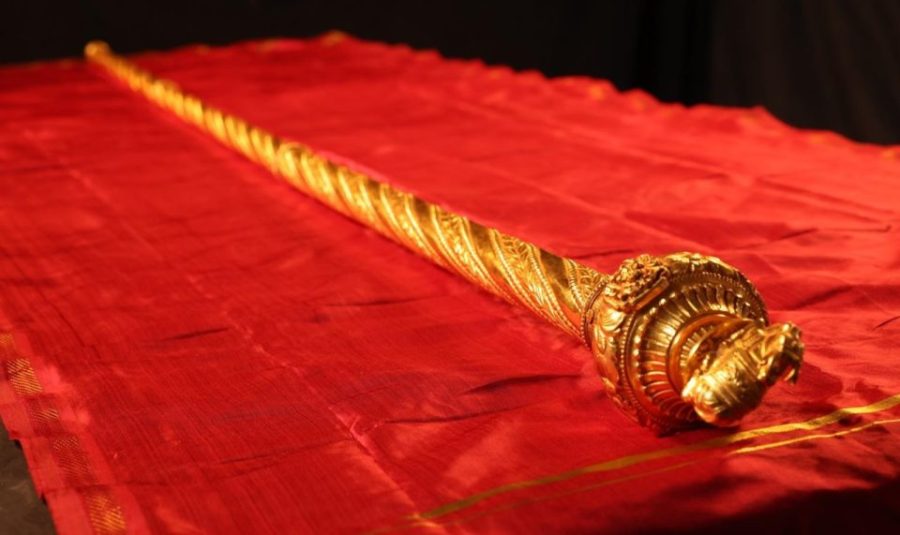
Explainer: What is 'Sengol', who crafted it and what's its significance?

When the much-talked about new parliament building will be inaugurated with fanfare on May 28, a “significant historical” symbol of India’s Independence is all set to become one of the key attractions at the event.
This symbol, much like the British king’s ancestral glittering objects of power, is a golden impressive sceptre called a “Sengol” (which derives from the Tamil word semmai, meaning righteousness). This Sengol, whose origins can be traced to Tamil history and traditions and which represents ‘power and justice’, has been plucked out of obscurity to soon occupy pride of place near the Parliament Speaker’s seat.
It will be placed there in a ceremonial fashion by Prime Minister Narendra Modi.
Making the announcement about weaving in the historic sengol imbued with meaning into the inauguration of the new parliament building, Union home minister Amit Shah told the media, “This sengol has huge significance. When PM Modi got to know about this, he asked to get more info on this…”
So, what is this Sengol, which has a celebrated past and why has it been revived to be used in the inauguration of the new Parliament building?
What is the sengol?
Measuring five feet in length, this gold coated silver sceptre features an intricately carved ‘nandi’ at the top, which is meant to represent the concept of justice.
When was it made and by whom?
It was made during the time of Independence in 1947, when the British handed over power to India. It was crafted by the famous jewellers, Vummidi Bangaru Jewellers in Chennai.
Also read: Historically significant ‘Sengol’ will be installed in new Parliament building: Shah
Why was it made?
Lord Mountbatten, the last British viceroy, wanted to mark the epoch moment of the ceremonial transfer of power from the British to the Indians. He approached Jawaharlal Nehru, who reportedly turned to Indian National Congress colleague C Rajagopalachari for his views on the matter.
After some research, Rajagopalachari came up with the idea of the sceptre that was used in Tamil tradition. When a new king assumes power, a high priest hands over a sceptre to him. This was the tradition observed by Cholas, suggesting this same practice can be used to mark India’s freedom from the British Raj, he is said to have told Nehru.
Tasked with the job of getting a sceptre done, Rajagopalachari reached out to Thiruvaduthurai Atheenam, a prominent religious institution in present-day Tamil Nadu. The spiritual leader of the mutt at that time assigned the work to Vummidi Bangaru, who helped in designing and procuring the sceptre.
Who was given the sengol?
After the sengol was ready, the priests sprinkled it with Gangajal. And as home minister Shah told reporters, “At around 10.45 PM on August 14, 1947, late Prime Minister Pandit Jawaharlal Nehru received this sengol from Tamil Nadu, and in the presence of several senior leaders, he accepted this as a symbol of achieving independence. It is a sign of a shift of power from Britishers to The people of this country.” A special song was composed and rendered as the sceptre was handed over.
So, what does the sengol stand for today?
The sengol has since assumed importance as the sceptre of righteousness. It is a reminder of India’s diversity and the birth of a great nation.
Also read: Opposition parties likely to boycott new Parliament building inauguration
Where is the sengol kept today?
It has been preserved in a museum in Allahabad since 1947.
What did the sengol embody in the past?
Dating back to the Chola dynasty, such sceptres were used in the coronation of kings. It served as a ceremonial spear and was considered a sacred symbol of authority, representing the transfer of power from one ruler to the next. The one accorded the ‘sengol’ is expected to impart a just and impartial rule.
How is the ‘historic sengol’ being revived today?
According to Shah, PM Modi learnt about this sceptre and asked that it be used in the inauguration after he learnt about its history. The sengol will be received by PM Modi before the official inauguration of the Parliament building, who will then prominently place it near the speaker’s seat.
As Shah said, “A historical event is being revived on this occasion. The historic sceptre, ‘Sengol’, will be placed in new Parliament building. It was used on August 14, 1947, by PM Nehru when the transfer of power took place from the British. It is called Sengol in Tamil, the meaning of this word is full of wealth”.
Further, the home minister said that the transfer of power is not merely a handshake or signing a document and that it must remain connected with local traditions keeping in mind modern needs. “Sengol represents the same feeling that Jawaharlal Nehru felt on 14 August 1947,” he said.
Shah also added that sengol represents the values of fair and equitable governance. This ‘staff of righteousness’ will shine near the Lok Sabha Speaker’s podium as a national symbol of the Amrit Kaal, an era that will witness the new India taking its rightful place in the world.

